November 25, 2022
Air Date: November 25, 2022
FULL SHOW
SEGMENTS

Low Ambition Climate Summit
View the page for this story
The annual meeting of the UN Climate treaty parties in Sharm el-Sheikh, Egypt known as COP27 went two days into overtime as negotiators worked late into the night hammering out a consensus. While the sleep-deprived delegates did produce an unprecedented agreement for rich nations to pay for loss and damage from climate disasters in poor countries, COP27 added no new brakes to keep the Earth from hurtling past the 1.5 degrees Celsius warming target of the Paris Agreement. Longtime observer of UN climate negotiations Alden Meyer, a senior associate at the think tank E3G, joins Host Steve Curwood to explain. (12:38)

Breakthrough for Loss and Damage
View the page for this story
One bright star from the recent UN climate treaty talks in Egypt (COP27) is the agreement for wealthy nations to create a fund to pay for “loss and damage” from impacts of the climate disruption to lower income countries. But no money has been provided yet to stricken nations and there are still plenty of details to be worked out. Sindra Sharma, the global policy lead for Climate Action Network International, joins Host Steve Curwood to talk about the decision and the challenges of the session in Egypt. (08:15)

Beyond the Headlines
/ Peter DykstraView the page for this story
Environmental Health News Editor Peter Dykstra joins Host Steve Curwood to share good news for salmon on the Klamath River, where four major dams are slated to soon come down. Also, a survey finds that climate activists who threw soup on a Vincent Van Gogh painting may not have helped the cause of climate action. And in the history calendar, 11 years ago attorneys for Tokyo Electric Power tried to argue that the radiation released by its Fukushima plant was no longer the company’s problem – because it was owned by the people it fell on. (04:51)

Living on Earth Gives Thanks
View the page for this story
To celebrate Thanksgiving, the cast and crew of Living on Earth shares the things we’re grateful for this year. (04:49)

Note on Emerging Science: Eel-icit Affairs
/ Don LymanView the page for this story
European eels journey three to six thousand miles from the rivers of Europe to the Atlantic Ocean, and now thanks to satellite trackers, researchers have the first direct evidence that the Sargasso Sea is where they mate. Living on Earth’s Fern Alling unpacks the significance of this discovery and how it can help protect these critically endangered animals. (01:47)

Cleaning Up Crypto
View the page for this story
Cryptocurrencies like Bitcoin can take a huge toll on electricity rates and the climate. That’s because “mining” cryptocurrencies typically involves massive amounts of computation, which takes lots of energy that’s mostly sourced from burning fossil fuels. But now there’s a far more efficient way to earn new coins if cryptocurrency managers decide to adopt it. Alex deVries is the founder of Digiconomist and a PhD candidate in Economics at Vrije University in Amsterdam and joins Living on Earth’s Jenni Doering to discuss. (14:07)

“The Nutmeg’s Curse”: Join the next LOE Book Club!
Join the Living on Earth Book Club on November 28th at 4 p.m. Eastern on Zoom for an interview with award-winning author Amitav Ghosh. His book ‘The Nutmeg’s Curse: Parables for a Planet in Crisis’ uses the haunting history of how nutmeg became a staple of the spice rack to reveal how colonialism and the commodification of the Earth’s resources has led us to the climatic tipping points and global crises we face today. ()
Show Credits and Funders
Show Transcript
221125 Transcript
HOSTS: Steve Curwood
GUESTS: Alden Meyer, Sindra Sharma, Alex de Vries
REPORTERS: Fern Alling, Peter Dykstra
[THEME]
CURWOOD: From PRX – this is Living On Earth.
[THEME]
CURWOOD: I’m Steve Curwood.
The UN Climate summit fails to reduce warming emissions but does agree to loss and damage funding for vulnerable countries.
ESSOP: This decision taken on African soil brings hope for vulnerable impacted peoples and communities, not just in the continent, but for the entire global south.
CURWOOD: Also, the cryptocurrency Ethereum changed its production system to be less energy intensive.
DEVRIES: As a result of this change the network probably reduced its energy consumption somewhere between 99.84% to 99.9996%, which is of course a tremendous reduction given that they were previously consuming as much power as a country like Austria.
CURWOOD: That and more this week on Living on Earth – stick around!
[NEWSBREAK MUSIC: Boards Of Canada “Zoetrope” from “In A Beautiful Place Out In The Country” (Warp Records 2000)]
[THEME]
Low Ambition Climate Summit
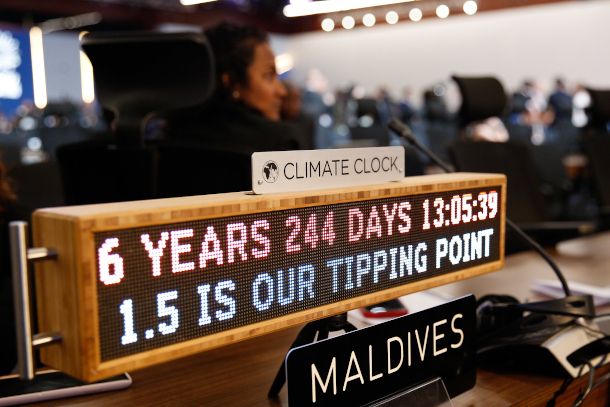
The Maldives delegation featured a “climate clock” at the COP27 climate summit in Sharm el-Sheikh, Egypt, November 2022. (Photo: UNclimate change, Flickr CC BY-NC-SA 2.0)
CURWOOD: From PRX and the Jennifer and Ted Stanley Studios at the University of Massachusetts Boston, this is Living on Earth. I’m Steve Curwood.
Every year since 1995 the UN holds the climate summit conference of the parties, or COP, and invariably it goes into overtime at the finish as delegates from nearly 200 countries wrangle all night long about fixing the climate crisis. This year COP27 in Sharm el-Sheik, Egypt, took the bronze medal for tardiness, running two days late before finally hammering out a consensus. Except for sessions in Spain and South Africa, it was the longest COP in nearly three decades of annual climate treaty talks. The sleep-deprived delegates of COP27 did produce an unprecedented agreement for rich nations to pay for loss and damage from climate disasters in poor countries, though no money is on the table yet. But the rest of the decisions at COP27 were far more pleasing to the fossil fuel industry than climate protection activists. They warn COP27 added no new brakes to keep the Earth from hurtling past the 1.5 degrees Celsius warming target of the Paris Agreement. Tasneem Essop is the international Executive Director of Climate Action Network International and spoke at the final post-midnight plenary:
ESSOP: This decision taken on African soil brings the hope for vulnerable impacted peoples and communities, not just in the continent, but for the entire global south. This is a first step in a process to rectify the systemic injustice to billions of people, particularly in the Global South, who are the least responsible, but are on the frontlines of the climate crisis. We know that the hard work to operationalize the fund and mobilizing the funding starts now. We will be watching this process carefully and will not have patience for delay or obstruction to progress. While COP 27 begins to address the consequences of the climate crisis, it failed to commit to phasing out fossil fuels, which are at the root of the climate crisis. More fossil fuel extraction means more losses and damages and more devastation. We need a rapid, just, and equitable transition away from the fossil fuel era and into renewables. There is no climate justice without human rights. We are not yet defeated. We will never be defeated.
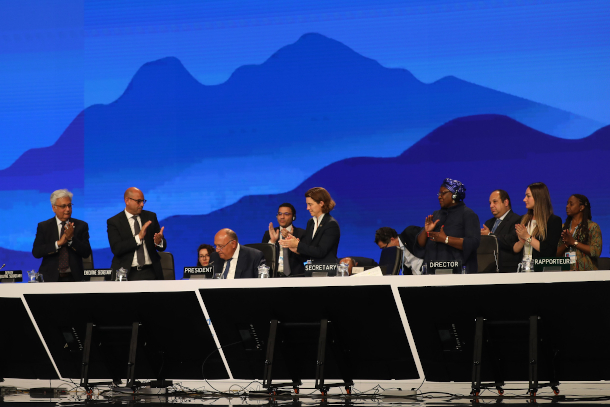
Negotiators applauded as COP27 wrapped up on the morning of November 20, 2022, after going into overtime. (Photo: UNclimate change, Flickr CC BY-NC-SA 2.0)
CURWOOD: Tasneem Essop, the international Executive Director of Climate Action Network International. For more on COP27 I’m joined now by Alden Meyer, a Senior Associate of the think tank E3G and longtime observer of UN climate negotiations. He’s just back from Egypt. Welcome to Living on Earth, Alden!
MEYER: Great. Thanks, Steve. Good to be with you again.
CURWOOD: So what's your reaction to the final text for the Conference of the Parties, number 27? Worst COP yet, some have said; how say you?
MEYER: Well, it was really a mixed bag. As you noted, we did have a breakthrough agreement on setting up a fund for loss and damage, which is helping the most vulnerable countries address the now unavoidable impacts of climate change. That still needs a lot of work to stand up and most importantly, to identify funds to go into the new fund. That was the bright spot. But on the downside, we really did not build on last year's COP in Glasgow, in terms of keeping 1.5 C alive. And we really didn't see much progress, not just at the COP, but over the last year since Glasgow, in countries stepping up to the plate and increasing ambition. So at last year's COP in Glasgow, a number of us, including Alok Sharma, the president of the COP, was saying that "1.5 C is in critical care." I'm afraid it's moving towards hospice care unless we dramatically ramp up action over the next year. It's still scientifically possible and technically possible to achieve 1.5 C, but it may be slipping out of reach in terms of the politics of it, and the radical transformation we need in ambition to get there.
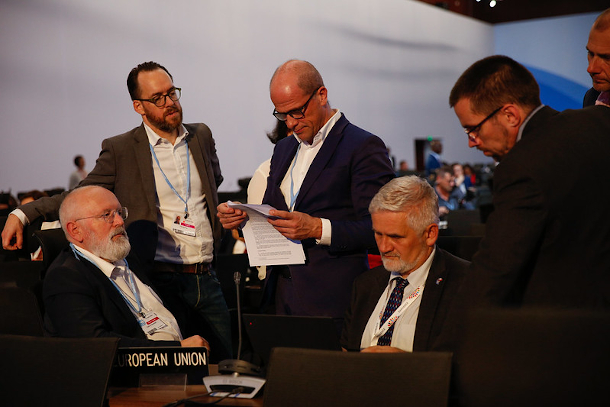
Delegates from the European Commission discussed the negotiating text in the early morning hours of November 20, 2022 (Photo: UNclimate change, Flickr CC BY-NC-SA 2.0)
CURWOOD: Alden, early on, there appeared to be broad support for language about phasing down the use of fossil fuels, beyond coal to gas and oil to be included in the final text from COP 27. Why was that ultimately scrapped?
MEYER: Well, we had India actually taking the lead on pushing to expand the fossil fuels away from coal and to include oil and gas. And there were more than 80 countries supporting that. But the Egyptian presidency never put that in the text. They were confusing their own national interests as a gas producer and exporter with their responsibility as the presidency to be a neutral broker. And you had a coalition of petro states such as Russia, Saudi Arabia, and Iran, with China and Brazil, vociferously opposing inclusion of that language in the decision. And as you know, Steve, under the UNFCCC, they have to operate on a consensus rule basis. And so they were able to block that addition at the end of the day, but I think it really has teed the issue up for the COP next year in Dubai, UAE and there will be pressure to take action on the mitigation side, which was really blocked in Sharm el-Sheikh.
CURWOOD: Give us an example, if you would, of the lack of transparency by this Egyptian presidency of this conference.
MEYER: Well, the Egyptians really were not transparent. One example would be on the final night before the closing plenary, they were showing countries texts of what they proposed to put forward. They weren't allowing them to have them in writing, they weren't allowing them to take pictures of them. For example, Frans Timmermans, who represents the European Union, was called in and had about fifteen minutes to look over the draft decision text. He was not allowed to have additional representatives from the EU in the room, he had to go back and, from memory, describe what he had seen. This is no way to run a process. The Egyptians clearly were trying to ram through texts that slowed down progress towards decarbonization and protected the fossil fuel countries and industries. And they didn't want to give the EU, the small island states, and other progressive forces time to regroup and prepare to object to this in the closing plenary. So that's just one example of how this process was not fair, inclusive and transparent.
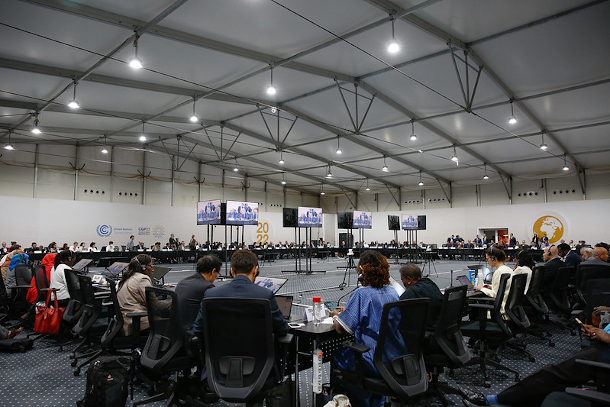
The heads of delegations met in a large hall on November 19, 2022, as COP27 ran into overtime (Photo: UNclimate change, Flickr CC BY-NC-SA 2.0)
CURWOOD: Alden, the big success of this conference that's being touted is that of a fund for loss and damage. To what extent is this agreement an admission by the developed nations of the world that they are responsible for the climate emergency?
MEYER: Well, I think it is an acknowledgment of that. They've resisted this for years now, if not decades, because of concern that they could be held liable for producing the largest share of historical emissions. But I think the pressure became overwhelming here based on a number of factors. You had the unity of the G77 and China block of developing countries, who were led this year by Pakistan, which is kind of the poster child for the impacts. You probably know that the damages imposed on Pakistan by the recent flooding could total $30 or $40 billion. And yet the aid that's been on offer from the US and Europe and others only amounts to a few hundred million dollars, about one percent of that total. So it really hit the breaking point, in terms of developed countries having to acknowledge not only the reality of the problem, but their responsibility to help address it. And so I think that's what really led to this decision. The other factor, of course, was some developed countries such as Canada, New Zealand and ultimately the European Union, agreeing that there needed to be this fund set up. And that put incredible pressure on the US to also drop its objections as it was isolated towards the end of the two weeks in Sharm el-Sheikh.
CURWOOD: There’s been promises of money for developing countries for years. I'm thinking, back in 2009 at Copenhagen, this $100 billion dollar a year fund to help with climate adaptation and mitigation was called for; it's yet to be fully funded. How did those funding arrangements fare at this COP? What additional energy was given to get those earlier promises moving?
MEYER: Well, that $100 billion dollar a year commitment was made in Copenhagen in 2009. There was a report put out by Germany and Canada just weeks before the COP saying that it has yet to be met, but predicting that it will be met next year. But of course, the $100 billion dollars itself is totally inadequate to the need to help developing countries decarbonize their economies and to deal with the impacts of climate change. On decarbonization, the International Energy Agency estimates that we need to generate somewhere between $2 and $4 trillion a year to help move away from coal and other fossil fuels to clean energy in these countries. And there are estimates that for adaptation and loss and damage, we could also be talking in the upper hundreds of billions, if not trillions. So it was discussed; the bigger focus, though, was really on what comes next with this new loss and damage fund, as well as what's going to replace the $100 billion dollar commitment after 2025, which is a big focus of discussion.
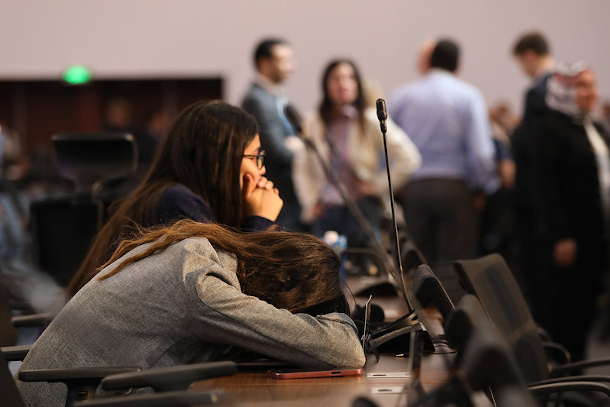
Fatigue set in as the negotiations wore on into the early morning hours of November 20, 2022. (Photo: UNclimate change, Flickr CC BY-NC-SA 2.0)
CURWOOD: By the way, how did the the meetings of the G20, those large economies— they met in times that really overlapped with COP 27. How did that play into the COP climate discussions this time?
MEYER: Well, the G20 Summit in Bali, which happened on Tuesday and Wednesday of the second week of the COP, actually was productive. It reiterated the commitment to the 1.5 Celsius temperature goal, it reiterated the commitment to phase down finance for fossil fuels. It did some useful things on the energy transition and how to speed that up towards clean energy. So it was a helpful force, and also, of course, the bilateral meeting between President Xi and Biden, on the Monday before the G20 in Bali was helpful. That enabled the restart of the US climate working group with China; towards the end of the second week, there were meetings between Special Envoy Kerry and Minister Xie Zhenhua of China. So that's going to get up and running again. So there were some positive signals. And of course, now we're looking forward to next year when India will be hosting not just the G20, but hosting the summit meetings of the Clean Energy Ministerial and Mission Innovation processes and hopefully, taking up the cudgel on pushing for expansion of the shift away from fossil fuels to include not just coal, but oil and natural gas.
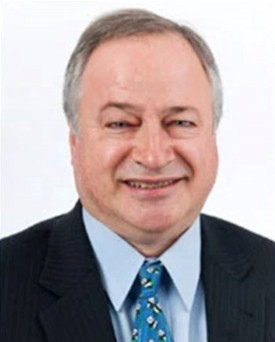
Alden Meyer is a Senior Associate at E3G working on US and international climate policy and politics. He is a Principal at Performance Partners, which provides a range of consulting services to clients in government, business, and the non-profit sector. (Photo: Courtesy of Alden Meyer)
CURWOOD: What confidence is there in the COP process, the UN Framework Convention on Climate Change negotiations, with another oil state, in this case, Dubai, coming aboard next year?
MEYER: Well, the UAE has made very clear that it intends to continue to be a producer of fossil fuels. The king of the UAE made that statement in his opening speech on the first Monday of the COP. But UAE has also been a progressive force in terms of deployment of renewables. It hosts the International Renewable Energy Agency. It has talked about wanting to have a major focus of the COP next year be on decarbonization, technological innovation and ways forward. So we're hopeful that it will be a force for good on that front. I think UAE has also learned a lesson watching the criticism that the Egyptians took for the way they managed the process: the lack of transparency, the chaos in the negotiations, conflating their role as the presidency of the process with their role as a major gas producer. So hopefully the UAE will run a better COP and we will really have a focus on the need to radically ramp up action on decarbonization if we're to have any hope of keeping the temperature goals in reach.
CURWOOD: Alden Meyer is a Senior Associate at the Climate Change Think Tank E3G and a veteran of the UN climate summit talks. Thanks for taking the time with us today, Alden.
MEYER: Thanks, Steve. It was great to be with you again.
Related links:
- BBC | “COP27: Climate costs deal struck but no fossil fuel progress”
- E3G: “Unpacking COP27: finance, fossils, climate impacts”
- About Alden Meyer
[MUSIC: Kenny Burrell, “Midnight Blue – Remastered” on Midnight Blue (The Rudy Van Gelder Edition), Blue Note Records]
CURWOOD: Coming up – taking time to count our blessings at this time of giving thanks. Keep listening to Living on Earth.
ANNOUNCER: Support for Living on Earth comes from Sailors for the Sea and Oceana. Helping boaters race clean, sail green, and protect the seas they love. More information at sailorsforthesea.org. Support also comes from Friends of Smeagull the Seagull and Smeagull’s Guide to Wildlife. It’s all about the wildlife right next door to you! That’s Smeagull, S - M - E - A - G - U - L - L, SmeagullGuide.org.
[CUTAWAY MUSIC: Kenny Burrell, “Midnight Blue – Remastered” on Midnight Blue (The Rudy Van Gelder Edition), Blue Note Records]
Breakthrough for Loss and Damage
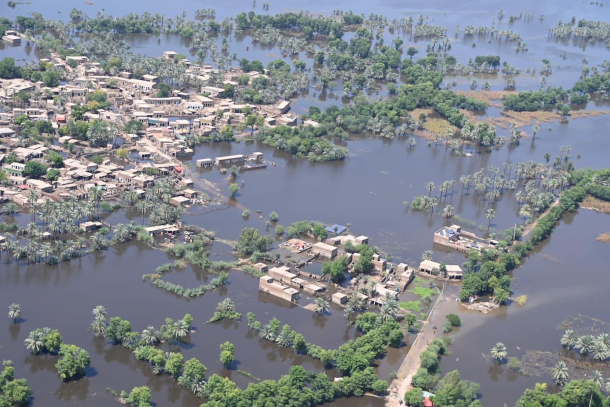
An aerial photo of flooded Sindh province in Pakistan in August 2022. Pakistan is a “poster child for impacts” from climate change, Alden Meyer says, since losses and damages from those floods could total $30 or $40 billion. (Photo: Ali Hyder Junejo, Flickr, CC BY 2.0)
CURWOOD: It’s Living on Earth, I’m Steve Curwood.
As we mentioned earlier, one bright star from the recent UN Climate treaty talks in Egypt is the adoption of provisions that now require affluent nations to pay something to poor nations for loss and damage from climate related disasters. But there are still plenty of details to be worked out. Questions include how much, where banked and who pays? Since CO2 remains in the atmosphere for centuries, the US is most responsible for global warming, having made the biggest portion of human related carbon emissions over time, closely followed by Europe. So, some say the US and Europe should pay, while others say China, which now leads the world with current emissions, should also pay. Such questions are set to be settled at future COPs. Sindra Sharma is the global policy lead for Climate Action Network International, and we called her up in her hotel room in Cairo. I asked her how she feels about finally having this admittedly vague loss and damage language incorporated in the world’s climate treaty.
SHARMA: It's a bit bittersweet. I think it is definitely a big step in the right direction. But it's something that has been delayed and sort of demanded for the last 30 years. So this is why it's a bit bittersweet because it's something that we needed many years ago. And what we have now is, is progress. But we need to make sure that it's progress in the right direction.
CURWOOD: To what extent did the disasters in Pakistan this year affect the discussions? I mean, we saw both record heat and then this crazy flooding, I think a third of the people in Pakistan lost their homes in these floods. What impact did that set of events have on the discussions?
SHARMA: What we saw this year in terms of impacts was really extreme, you know, like, all over the world, the Pakistan floods is one example. But in Sub-Saharan Africa, in the Horn of Africa, you have this ongoing drought, this flooding in numerous places across the globe. The challenge that happened, the complete destruction that happened in Pakistan was always referred to as were the other impacts. And this was really coming from developing countries to show the, the sort of visceral, real-lived experience of what they're going through right now. But it was also acknowledged by developed countries that this is really something crazy. This is really something extreme that we're now experiencing. So that did bring a sense of urgency to the conversations and the negotiations.
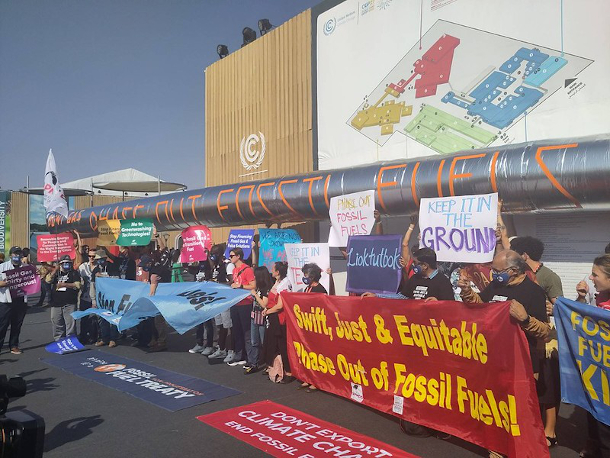
A protest by climate activists during COP27 in Sharm El-Sheikh, Egypt. (Photo: Courtesy of Ayumi Fukakusa, Friends of the Earth Japan, Flickr, CC BY-NC-ND 2.0)
CURWOOD: Now, how soon can developing nations access the loss and damage fund?
SHARMA: That is the million dollar question at the moment. The timeframe of this fund is not very clear. But from the perspective of civil society from G77 and China, who were very united in their demands, it would lead to the operationalization of the fund at the latest by COP29. So then you'd start already having money flowing to those who really need it by COP29.
CURWOOD: That's two years from now.
SHARMA: Yeah, that's two years from now, so that's already late. But we've been waiting for 30 years for this tiny opening that we can now run with.
CURWOOD: How much money are we talking about here in terms of loss and damage?
SHARMA: So in terms of loss and damage, at the moment, the ability to quantify it is actually really difficult, because you're looking at a dimension of a very complex sort of dimension of losses and damages. And that includes non-economic losses, which are just by the name of it as well, not really easy to quantify. So from some of the analysis that's been done, it's between $200 to 380 billion a year, just to address the economic losses and damages. And we can see from the examples as well, from the flooding in Pakistan, from small island states that have lost quantums of their GDP as well from a single extreme event, that this number is a vast underestimate.
CURWOOD: So the non economic losses; what are we talking about here? To what extent is a consider the loss of human life, for example?
SHARMA: Yeah, so that's exactly—non-economic losses includes the loss of human life. It includes health as well, which also can be quantified from, you know, a few studies to look at the impact on work, so on labor as well. And then what's tangible to us, but intangible economically, perhaps, which includes our culture, our sense of belonging, our sense of identity, the sense of community, the place that we bury our ancestors and we call our home, like losing all of that has a huge profound impact on people and being displaced from your communities because of something that you don't have control over, and then you have to journey from one place to the next to the next, and at each of those stages of journeying, you might not be wanted, right? You might be called a refugee, and not associated with the climate impacts that have made you to move. So there's a whole quantum of—of things to consider.
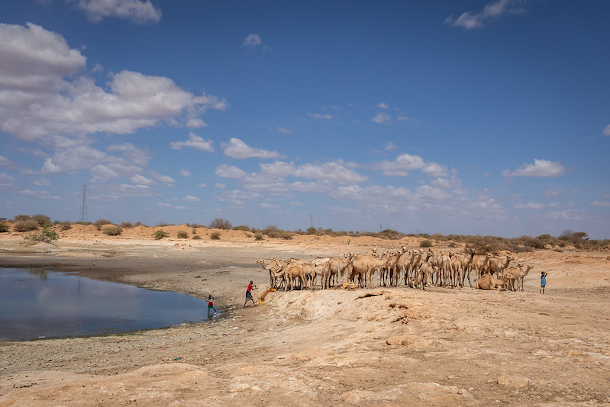
People and animals crowd a water pond in Beda’as kebele in Ethiopia in January 2022. These water ponds become one of the few sources of water when drought hits the Somali Region. (Photo: Courtesy of Mulugeta Ayene, UNICEF Ethiopia, Flickr, CC BY-NC-ND 2.0)
CURWOOD: Sandra, what country are you from? And what sorts of losses and damages has your nation suffered as a function of climate disruption?
SHARMA: I'm actually from Fiji. So I'm from a small-island developing state in the Pacific. And my country has suffered a lot from losses and damages. With every passing hurricane and cyclone season there is always a fear. Is this going to be more extreme than the other? And how will we rebuild when it's too extreme? You know, so, there's also a very steep learning curve as well. So a lot of communities have already started the process of relocation. And we're lucky at the moment that that’s generally relocating your village from closer to the coast to more inland, but that still has had a huge impact. And we're learning from those and putting that into lessons learned and best practice so that we can ensure that when there is no assistance flowing to us that we can help ourselves, basically.
CURWOOD: COP27 came up with a mechanism finally to deal with loss and damage. Yet, this gathering, this UN Climate Summit, didn't do anything more to put the brakes on climate disruption. How do you feel about that?
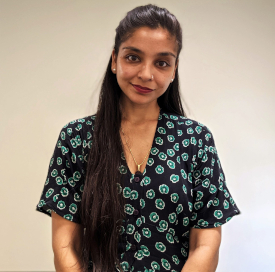
Sindra Sharma, Climate Action Network International global policy lead. (Photo: Courtesy of Sindra Sharma, Climate Action Network International)
SHARMA: So from my perspective, for me, this COP was extremely unsettling. And it really... it didn't sit right in terms of the process. And I think we need to have a hard-think and be brave around how we can challenge this system that at the moment is broken. You know, this is a climate conference; why would you invite the most amount of fossil fuel lobbyists to a climate conference? And they then influence the outcome of the decision so that we have a weaker decision around the phase out of fossil fuels, which is essential to be able to mitigate climate change to be in line with 1.5 to ensure that we don't have the severity of losses and damages that we see as we go forward, where there's even deeper vested interest in maintaining the expansion of gas, for instance. I mean, it was sold at this COP already in the opening plenary as a clean fuel. So these are solutions that we just cannot anymore, you know, have a focus on but we still seem to be in this cycle of backsliding. So I found this COP really challenging from a human rights perspective. As a Fijian as well, I see that our time is significantly running out. Every second wasted is a second that we can't get back.
CURWOOD: Sindra Sharma is the global policy lead for the Climate Action Network International. Thanks so much for taking the time with us today.
SHARMA: Thanks for having me.
Related links:
- Click here to read the unedited version of the COP27 decision on loss and damage fund here
- The Guardian | “A deal on loss and damage, but a blow to 1.5C – what will be Cop27’s legacy?”
- Read more responses from climate activists on the loss and damage decision on COP27
- The Conversation | “COP27’s ‘loss and damage’ fund for developing countries could be a breakthrough – or another empty climate promise”
- Read a 2021 OECD report on managing climate finance for loss and damage risk reduction
[MUSIC: Ahmad Jamal, “Excerpts From The Blues” on Happy Moods, Verve Label Group]
Beyond the Headlines

The Klamath River is one of only three rivers that bisect the Cascade Mountain Range, flowing from the high-desert interior through coastal rain forest to the Pacific Ocean. The river supports Chinook salmon, coho salmon, steelhead trout populations and other “anadromous” species that migrate between their ocean feeding areas and freshwater spawning streams. (Photo: Bob Wick, BLM, Flickr CC BY 2.0)
CURWOOD: With me now on the line from Atlanta, Georgia is Peter Dykstra. Yes, that Peter Dykstra, the one who is an editor for Environmental Health News–that’s ehn.org, also daily climate.org–and who brings us years of experience to looking at the environment. So, what do you have for us today during this Thanksgiving season, Peter?
DYKSTRA: Hi, Steve, and happy Thanksgiving, season to all. Some potential good news, especially if you're a salmon, making his or her way up the Klamath River in California and Oregon. And I'm not saying that you are a salmon, Steve, but here's what's going on. The world's largest potential dam removal may soon happen in the Klamath. It’s one of four that river basin. Removing the dams may affect the generation of hydropower, but it will certainly affect in a positive way, the ability of salmon to swim upstream to spawn and for both Native Americans and commercial fishermen to catch salmon in an area that used to be one of the most prolific areas for salmon in the entire Northwest.
CURWOOD: Yeah, I think some of the Native Americans have said that salmon is literally critical for their survival, and that these dams have, have really made their survivability quite difficult. So I'm sure they see that as good news. Hey, what else do you have for us today?
DYKSTRA: A couple of weeks ago there was news made in Europe because climate activists threw tomato soup on a Vincent van Gogh painting, one of his most famous, Sunflowers. There was a study done of Americans by the University of Pennsylvania to see if they thought that throwing tomato soup on a classic painting actually helped the cause of climate action. Forty six percent of the thousand surveyed said it did not. Thirteen percent said it helped. Forty percent said they didn't think it mattered at all. But that plurality of people surveyed, saying that an attempt to increase climate action support backfired.
BREAKING: Environmental activists from have thrown tomato soup over Vincent van Gogh’s iconic Sunflowers painting hanging in London’s National Gallery.https://t.co/r6c9tn6h5L
— Metro (@MetroUK) October 14, 2022
CURWOOD: Well, thank heavens, the flowers, I think were encased in glass, right? They weren't damaged. But sounds like the movement that these folks are trying to start is being damaged by this tactic.
DYKSTRA: It is and to me if you carry it to its logical conclusion, it's like expecting the world to support you because you threw a pie at the Mona Lisa. It just doesn't make sense. And to me, it helps enforce the idea that climate activists are engaging in futility. That's not the right image you want to cast.
CURWOOD: Anything else you want to tell us before we head to history?
DYKSTRA: Yeah, one death that should be recognized is Herman Daly. He died at 84 earlier this month. He was the economics professor who introduced ecology with so much of its dismal outcomes to economics, the so called dismal science, married the two, which sounds like a pretty dismal career, but a very, very important one, to make sure that in dealing with global economics we recognize that birds and trees and water and air and everything on our earth has a price. And it could be a positive price or it could be a negative price in the face of environmental disaster.
CURWOOD: And just like money can't buy love, money cannot buy back a destroyed environment.
DYKSTRA: Many times that's true.
CURWOOD: All right, let's take a look now at the history vaults. What do you see today, Peter?
DYKSTRA: Eleven years ago, November 24, 2011 attorneys for Tokyo Electric Power went into a Japanese courtroom where they were being sued for radiation damage from the Fukushima nuclear plant meltdown. And those lawyers argued that once that radiation was released, it was no longer Tokyo Electric’s problem because the radiation was owned by the people it fell on.

International Atomic Energy Agency experts depart Unit 4 of TEPCO’s Fukushima Daiichi Nuclear Power Station on 17 April 2013 as part of a mission to review Japan's plans to decommission the facility following the 2011 nuclear disaster. (Photo: Greg Webb, IAEA, Flickr, CC BY SA 2.0)
CURWOOD: You're kidding, Peter. They really made that argument in court?
DYKSTRA: Yeah, they did. The radiation argument did not stick with the judge no pun intended. It didn't get very far but it's an example of just how ridiculous some of the efforts to defend against environmental damage can get.
CURWOOD: Certainly is. Hey, thanks Peter. Peter is an editor with environmental health news, that’s ehn.org and daily climate.org. We'll talk to you again real soon.
DYKSTRA: All right, Steve. Thanks a lot. Talk to you soon.
CURWOOD: And there's more on these stories on the Living on Earth webpage. That's loe.org.
Related links:
- OPB | “The world’s largest dam removal will touch many lives in the Klamath River Basin”
- The Guardian | “Just Stop Oil activists throw soup at Van Gogh’s Sunflowers”
- Learn more about Herman Daly
- The Washington Post | “Herman Daly, professor who introduced ecology to economics, dies at 84”
- Article from 2011 talking about TEPCO’s Handling of the Fukushima Crisis
[MUSIC: Chet Baker, “Autumn Leaves” on Jazz Moods – Cool, Sony BMG Music Entertainment]
Living on Earth Gives Thanks

The LOE staff wishes all our listeners a happy Thanksgiving season! (Photo: Pro Church Media, Unsplash, public domain)
CURWOOD: Bobby Bascomb is joining me now. Hi there!
BASCOMB: Hi, Steve. So, you know, it’s that time of year again when we celebrate the harvest season and give thanks for the important things in our lives. So, I have to ask you, what are you thankful for this year?
CURWOOD: There’s so much and the best is love, for and from my family and friends and the nature around me. And of course, people who listen to our show. What about you, Bobby?
BASCOMB: So many things. I’m thankful for the beautiful place where I get to live and the wonderful community of friends that I have here. After these years of isolation with the pandemic I’m really grateful to be able to spend time in my community again.
CURWOOD: Oh, that’s so true.
BASCOMB: Yeah, and we put the same question to our crew here at the show and I just love their answers as well. Let’s have a listen.
[MUSIC: Bill Evans Trio, “Autumn Leaves – Album Version – (Take 1)” on Portrait In Jazz, Fantasy, Inc.]
DOERING: I'm Jenni Doering, I'm a producer here at Living on Earth, and this year I'm really thankful for the opportunity to watch nature in my own backyard here in Watertown, Massachusetts. We actually had a turkey hen lay eleven eggs in a nest in our backyard this spring. And it was really cool to watch them hatch out and watch the little babies foraging with their mother.
KAUSCH: I'm Mark Kausch. When I'm not working on program strategy for Living on Earth, I teach young people how to play the string bass and I'm thankful for my students: their wit, their passion, their energy. They remind me of how great life can be when we all find ways to deeply connect with each other.
BELTRAN: I'm Paloma Beltran. I'm a producer with Living on Earth, and I'm grateful for my family's health as well as the love and support of my wonderful partner.
REGO: I'm Jake Rego, technical director at Living on Earth. This year, I am thankful for all of my friends and family, their good health, and all of their help with renovating my new home.
ALLING: My name is Fern Alling. I'm an intern at Living on Earth and I am really thankful for my public library. It is such a calm and beautiful place to get all of my work done.
LENDER: I'm Mark Seth Lender, explorer in residence. We planted wildflowers this year. Maybe that's the reason the stinging insects have made friends with me. Yesterday, and not for the first time ,a wasp landed on my finger walked, around took off. I'm thankful because it's a connection with the natural world I'd never dreamed of.
O'NEILL: My name is Aynsley O'Neill. I'm an associate producer here at Living on Earth. I'm thankful for good books, good movies, and good music. And of course, all the good people to share these with.

One of the things we’re most thankful for here at LOE is the natural world around us. (Photo: Jakob Owens, Unsplash, public domain)
KAHFI: I'm Kharishar Kahfi, or Kuka, an intern with Living on Earth. I'm thankful for the opportunity to learn more about science and environmental journalism in grad school here in the US. Also, I'm grateful for finally graduating in December. I can't wait to get back reporting on the field.
SOEBROTO: I'm Ashley Soebroto and I'm an intern at Living on Earth. This year I'm thankful for all the friends and co-workers that I've met who have been so incredibly supportive, kind and helpful.
MALLISON: I'm Louis Mallison, I produce book interviews here at Living on Earth, which I'm very grateful for, along with the incredible diversity of life on earth that never fails to amaze and inspire me.
PANDELIDIS: I'm Sophia Pandelidis and I'm an assistant producer here at Living on Earth. This season, I'm especially grateful for all the time I've been able to spend outside enjoying this beautiful fall weather with my family and friends.
DYKSTRA: This is Peter Dykstra. I do the Beyond the Headlines segment with these folks every week. I'm thankful for the League of Conservation Voters just having gone through another election cycle with people slamming each other into the mud left and right. LCV provides information on the environmental track records of every senator and every congressperson. The League of Conservation Voters, somebody I've been thankful for for all of their 52 years.
CHEN: My name is Chloe Chen, I work with marketing at Living Earth. I'm thankful for my care and family. Even though we are 7,000 miles away from each other, we can still FaceTime to share our happiness and express love.
ARENBERG: I'm Naomi Arenberg and I choose the music every week. Our shining sun illuminates and warms the world around me. I'm thankful for that daily reminder to preserve Earth's gifts.
LYMAN: Hi, I'm Don Lyman and I write Science Notes for the show. I also teach part time at two colleges in a prep school in the Boston area. I'm thankful for the opportunity to work with some great colleagues and to teach so many wonderful students. Even the rambunctious high school freshmen I was teaching last week.
Related link:
Listen to what LOE gave thanks for back in 2021
[MUSIC: Bill Evans Trio, “Autumn Leaves – Album Version – (Take 1)” on Portrait In Jazz, Fantasy, Inc.]
CURWOOD: Coming up – For the first-time scientists can track the mating grounds for endangered European eels. We’ll have the details just ahead on Living on Earth.
ANNOUNCER: Funding for Living on Earth comes from you, our listeners, and United Technologies, combining a passion for science with engineering to create solutions designed for sustainability in aerospace, building industries, and food refrigeration.
[CUTAWAY MUSIC: Bill Evans Trio, “Peri’s Scope” on Portrait In Jazz, Fantasy, Inc.]
Note on Emerging Science: Eel-icit Affairs

European Eels used to make up over half of the total fish biomass in Europe’s rivers, but their numbers have dwindled dramatically in the past twenty-five years because of overfishing, parasites, barriers to migration and ocean current changes. (Photo: Robert Nunn, Flickr, CC BY-NC 2.0)
CURWOOD: It’s Living on Earth, I’m Steve Curwood.
Coming up: mining for cryptocurrency can use as much energy as some entire countries, but there is a better way. But first this, note on emerging science from Fern Alling.
[SCIENCE NOTE THEME]
ALLING: Scientists recently announced they were able to track European eels all the way to their mating site in the Sargasso Sea for the first time. It’s a big deal: Dutch scientist Johannes Schmidt first suggested the Sargasso was their breeding ground ninety-nine years ago but it was never confirmed. Now, at long last, we have the technology to test his hypothesis. UK researchers traveled to the Azore Islands, the furthest confirmed point on the eels’ migration. There, they caught 26 adult eels and attached satellite trackers to them. Six of the captured eels made it to the Sargasso Sea after a year. Like other freshwater eels, European Eels spawn in the Atlantic ocean. Then, they swim three to six thousand miles to the rivers of Europe. And when it’s time to get it on, they journey back to the Atlantic. But there’s a lot we still don’t know. Adult European eels have never been caught in the act, and we’ve never found their eggs in the wild. At least now we finally have proof that the Sargasso Sea is the sensuous spawning site of this slippery species. Conservation biologists are excited by this information because it could make it easier to protect eels. European eels are critically endangered and at a greater risk of extinction than more charismatic species like pandas or blue whales. In some parts of Europe, they used to account for over half of the freshwater fish biomass. Now, it’s 5 percent or less. The more details we have about eels’ bedroom habits, the better we can protect them while they conduct their eel-icit affairs. That’s this week’s note on emerging science, I’m Fern Alling.
Related links:
- Read the full study
- Learn more about the European Eel’s life cycle in this video
[SCIENCE NOTE THEME]
Cleaning Up Crypto

Most cryptocurrencies like Bitcoin still use an energy-intensive mechanism known as proof of work. In September 2022 the rival cryptocurrency Ethereum switched from proof of work to proof of stake, which vastly reduces the amount of computational work and therefore energy involved in earning new coins. (Photos: Bitcoin: Komers Real, Flickr CC BY 2.0. Ethereum: Quote Catalog, Flickr CC BY 2.0)
CURWOOD: Many of us still don’t quite understand how cryptocurrencies like Bitcoin work, and the sometimes devastating impact they can have on electricity rates and the climate. So, let’s pull back the curtain. Instead of currency issued by a government central bank, cryptocurrencies are like the promissory notes that local banks used to issue back in the early days of the United States. These bank notes could be traded, although bank failure could make them worthless, so people generally preferred gold and silver coins. Cryptocurrencies are modern-day versions of such private money. But instead of printing notes, crypto relies on ledgers kept on computers linked in blockchains, so records of transactions can’t be altered. Bitcoin is the most popular cryptocurrency and creators of blockchains needed to verify Bitcoin transactions are paid in Bitcoin. That process is called mining and it requires that computers solve complicated mathematical puzzles. And at any given moment the fleet of computers mining bitcoin uses more electricity than the entire nation of Austria, much of it from fossil fuels. So, there is climate risk as well as investment risk. But the climate risk doesn’t have to be that way. For more we called up Alex de Vries, the Founder of Digiconomist and a PhD candidate in Economics at Vrije Universiteit Amsterdam. He spoke with Living on Earth’s Jenni Doering.
DOERING: So what is it about cryptocurrency mining that requires so much energy? Can you kind of put this into context for us?
DEVRIES: Currencies like Bitcoin, they're open systems and theoretically anyone can help with processing new blocks of transactions for the underlying blockchain systems. In order to make these new blocks for the Bitcoin blockchain and any other mining based blockchain, you have to participate in what is effectively a massive game of guess the number, where your machine is just going through a process of trial and error trying to find a lucky number. And only when the machine succeeds, then you get to create the next block for the blockchain. That guessing process is where all the energy consumption is because the Bitcoin network by itself is now generating 200 quintillion guesses every second of the day non stop. That's 200 with 18 zeros. It’s an unimaginably large number.
DOERING: Wait, every second 200 quintillion?
DEVRIES: Yes, 200 quintillion. It's just trial and error, so everything that is wrong is immediately discarded. And again, they get it right only once every 10 minutes, despite all those attempts. And the reason why they do it is of course, they get a reward for it, because every block they create comes with its own reward. At the moment, 6.25 Bitcoins, which is of course a substantial amount of money.
DOERING: And of course, it matters where that energy is coming from, how it is being generated. Do we have a sense of how much of the energy that cryptocurrency mining is using is generated from clean sources of electricity versus dirtier sources of fossil fuel based power?
DEVRIES: So we can quantify that based on their current locations, the amount of renewables in their energy mix is probably just 25%. And the situation might even be worse than that because if you consider what actually happens when these miners take place in, for example, a state like Texas, in most situations on most grids, renewables actually come first in the merit order, which means that renewables are running and we use fossil fuels as a backup. If you increase demand on those grades, you're actually just adding more demand for fossil fuels, you're not adding more demand for renewable energy.

Traditional cryptocurrency mining to produce new Bitcoins and other currencies demands massive amounts of computational power. Most mining operations are comprised of networks of highly efficient computers working in tandem. (Photo: Brendan Lim, Flickr, CC BY-NC-ND 2.0)
DOERING: Yeah. A form of incentive that we do see over time with technologies as they develop is this drive towards efficiency. I'm wondering to what extent that's happened with cryptocurrency mining?
DEVRIES: Well, there are indeed efficiency improvements in the mining devices. But contrary to other industries, it doesn't mean that the energy consumption of the network goes down. I previously showed that the computational power of these machines is more than doubling per unit of energy every one and a half years on average. So, the improvement rate of the newly available devices is very, very high. The unfortunate thing is that in crypto mining, if these miners can afford to spend five billion per year on electricity, it doesn't really matter what device they have, you know, if you give them a more efficient device, they'll get two of that device instead of one.
DOERING: Yeah. China did ban the practice of cryptocurrency mining. That was back in 2021. They used to be the leading crypto mining country. Why did the government ban mining and how has that changed things in the industry worldwide?
DEVRIES: Well, they were the first to actually cite environmental reasons as a reason for kicking these miners out because there was a ruling that mining contracts are illegal in the face of the country's climate goals. They were previously hosting more than half of the Bitcoin network. According to data provided by Cambridge, we see that miners relocated from China to Kazakhstan and several states in the US like Texas, Georgia and Kentucky. Unfortunately, these miners, which were previously using relatively many renewables in China, when they moved to the US and when they moved to Kazakhstan, they actually lost a lot of access to renewables. Because in Kazakhstan the energy mix is almost entirely made up of coal. But even in the US, the states that I mentioned are strongly dependent on fossil fuels as well.
DOERING: You know, as cryptocurrency mining has shifted from China to other places, including the United States, there has been a real concern about that driving up electricity bills for local residents and businesses. I understand that there was a study by researchers at the University of California Berkeley that looked at upstate New York and they found that crypto mining pushed up bills for local residents by six percent. How can we ensure that cryptocurrency growth doesn't push up electricity prices for everyday citizens?
DEVRIES: Well, if you want to ensure that you shouldn't be allowing them on your grid. The thing is, if you are dealing with a limited energy supply, which is the situation on most grid, we don't have unlimited energy available, then obviously, if we're going to be giving part of that energy away to these miners and in some places like Texas, these miners have gotten really ridiculous contracts, like Ria Blockchain in Texas got a fixed rate contract up until the year 2030 and they're only paying two and a half cents per kilowatt hour. Well, I think locals are already playing around 20 cents per kilowatt hour, and the prices are still going up. If you enter into these contracts you're going to be reducing the available capacity for the rest of the grid and then it becomes a really simple situation of supply and demand. So yeah, of course, prices are going to go up. And of course, also related to that, fossil fuel use is also going to go up simply because we need to trigger our backup fossil fuel sources to be supplying them. And what do you get back from that? Well, a facility that provides really a low amount of jobs compared to the amount of power that it's using.
The bitcoin mining boom in Texas means the state is facing massive costs to shore up its shaky power grid, and consumers may be left with the bill https://t.co/iIHiTXMw0J
— Bloomberg Crypto (@crypto) March 15, 2022
DOERING: I believe in upstate New York, there was actually a cryptocurrency mining company that bought an old coal plant that was, you know, sitting idle and decided to restart it. What exactly happened there?
DEVRIES: Yeah, I mean, these miners are looking for cheap and constant power. If you have an obsolete gas plant, that is actually a very ideal target for this type of operation. What we saw is that in this case, the plant was a former coal plant, it was sitting idle and ended up being repurposed as a gas plant mainly for powering this new mining operation, which by the way, triggered a lot of resistance from the locals, to the extent that New York has very recently passed a new law to prohibit this from happening again. This exact scenario I think is an important signal because this industry typically claims that they are not just using renewables but actively boosting the use of renewables, which is a ridiculous claim, considering what's actually going on on the ground.
DOERING: So we've been talking a lot about Bitcoin, which is the most popular cryptocurrency. But there's also Ethereum, and I think it's around number two. And they recently made a really big switch in their operations, which may actually improve the efficiency. Can you explain what this switch was and what impact it's had?
DEVRIES: Yes, indeed. So previously, Ethereum was a massive contributor to the overall footprint of crypto assets in general. Their environmental impact was about half of what Bitcoin network's impact was so they were a pretty significant force to be reckoned with. What they changed is they got rid of the energy intensive proof of work mining process and they replaced it with a more environmentally friendly alternative known as proof of stake. And what that basically does, it changes the way in which new blocks are being created for the blockchain. So I talked about how in proof of work, you need to have very powerful energy hungry machines in order to be able to make new blocks for the blockchain and then the more machines you have, the bigger your chance of winning the lottery that will allow you to make the next block for the blockchain. In proof of stake, there is still a lottery but it works completely different. In fact, you have to acquire some Ether, 32 Ether at minimum, and then you put those coins as collateral in the staking process. And then the software will randomly select one of the stakers to create the next block for the blockchain. And that sounds a lot less energy intensive because it doesn't involve those energy hungry machines. You do still need a device with an active internet connection but how powerful the device does not matter. In fact, the only way to increase your odds in that system is by just accumulating more wealth, increasing your stake. So it kind of does away with the whole incentive to just consume more energy, get this really highly specialized and energy hungry equipment. And we can estimate that as a result of this change, the network probably reduced its energy consumption somewhere between 99.84% to 99.9996%. Which is, of course, a tremendous reduction, given that they were, you know, previously consuming as much power as a country like Austria by themselves.
DOERING: Wow, that's a huge reduction. So we're talking about maybe 1% or less of the energy consumption that it used to involve?
DEVRIES: Yeah, not even one percent, maybe not even 0.1%.
DOERING: Wow. So what kind of interest is there in the Bitcoin world or from other cryptocurrencies about making a similar switch?
DEVRIES: That's very interesting question because we know that in Bitcoin’s case if you were to even try to suggest this in the community they will just laugh at you and say it will never happen, and that's it. They don't have any motivation whatsoever to make this change. In fact, they have a bit of a history being very anti change, various upgrades that were proposing the past–In other communities, it will depend on which community you ask and how they might be more open to do something similar. But it really depends on the community. This is more of a social thing than it is a technical thing. You can replicate the success of Ethereum in making the switch happen in any live crypto asset. It can be done in Bitcoin, it can be done in any other crypto coin that is currently still running on the energy in terms of proof of work. But you need to have a community that is sufficiently willing to actually go ahead with it and that's where things get tricky.
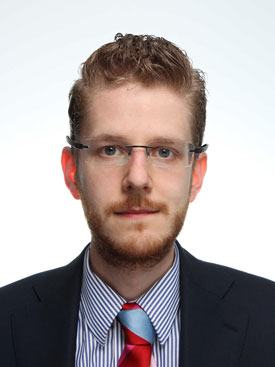
Alex de Vries is a data consultant and the founder of Digiconomist.net. (Photo: Alex de Vries)
DOERING: So at a time when energy costs are, in some places, are sky high, what role can governments play in reducing the carbon intensity of cryptocurrencies and reducing these energy demands that they put on entire grids?
DEVRIES: That is the tricky thing with Bitcoin mining, it is completely location independent. It doesn't matter where you put your mining machine, you can put it anywhere in the world. So if you kick them out of one location they'll just go to the next bad location. And I think that if a regulator wants to seriously do something about this industry, they should probably target the investors first. I mean, ultimately the environmental impact of these assets are closely related to the value of the asset. And if the price is zero, there is no environmental impact because miners don't make money. And as everyone just keeps getting into Bitcoin, which many large corporations actually pushing investments into Bitcoin, have to realize they're also facilitating an increase in value of Bitcoin, which ultimately reverberates environmentally, through the miners that are profiting from that as well. So from a policy maker perspective you can think about like, okay, environmental disclosure, make investors aware of what is going on behind the scenes,.We’re seeing this now in Europe, where disclosure is becoming mandatory for any crypto asset service provider to provide more information about the investments that they offer. But you could go a step further, how you could start working with environmental taxes to discourage investments in these assets, which would supposedly drive down the price. If you're discouraging people to invest, then you're going to drive down the price and in turn the environmental impact.
CURWOOD: That’s Alex de Vries, Founder of Digiconomist and a PhD candidate in Economics at Vrije Universiteit Amsterdam, with Living on Earth’s Jenni Doering.
Related links:
- Digiconomist Bitcoin Energy Consumption Index
- Digiconomist Ethereum Energy Consumption Index
- Bloomberg | “Crypto Mania in Texas Risks New Costs and Strains on Shaky Grid”
[MUSIC: Massane, “Floating” on Visage 5 (Floating), This Never Happened]
“The Nutmeg’s Curse”: Join the next LOE Book Club!

CURWOOD: Nutmeg is the spice we use to give a warm aromatic flavor to our cooking, especially around the holidays, but there’s a cold truth about its supply. The newest book from Amitav Ghosh is called “The Nutmeg’s Curse: Parables for a Planet in Crisis.” It uses the haunting history of nutmeg to reveal how resource extraction from the poor to benefit the rich has led us to the present global crises. Join me for our next installment of the Living on Earth Book Club on November 28th at 4pm Eastern for our live discussion with Amitav Ghosh. To register for this free event, visit the Living on Earth website at loe.org/events.
Related links:
- Sign up here
- Find a copy of the book here (Affiliate link helps support LOE and indie bookstores)
[MUSIC: Gyedu-Blay Ambolley, “Yekor Ye A Yeaba” Single, Agogo Records]
CURWOOD: Living on Earth is produced by the World Media Foundation.
Our crew includes Fern Alling, Naomi Arenberg, Bobby Bascomb, Paloma Beltran, Chloe Chen, Iris Chen, Josh Croom, Jenni Doering, Mark Kausch, Kharishar Kahfi, Mark Seth Lender, Don Lyman, Louis Mallison, Aynsley O’Neill, Sophia Pandelidis, Jake Rego, Ashley Soebroto, and Jolanda Omari. Tom Tiger engineered our show. Alison Lirish Dean composed our themes. You can hear us anytime at L-O-E dot org, Apple Podcasts and Google Podcasts, and like us, please, on our Facebook page - Living on Earth. We tweet from @livingonearth. And find us on Instagram at livingonearthradio. I’m Steve Curwood. Thanks for listening!
ANNOUNCER: Funding for Living on Earth comes from you, our listeners, and from the University of Massachusetts, Boston, in association with its School for the Environment, developing the next generation of environmental leaders. And from the Grantham Foundation for the protection of the environment, supporting strategic communications and collaboration in solving the world’s most pressing environmental problems.
ANNOUNCER 2: PRX.
Living on Earth wants to hear from you!
Living on Earth
62 Calef Highway, Suite 212
Lee, NH 03861
Telephone: 617-287-4121
E-mail: comments@loe.org
Newsletter [Click here]
Donate to Living on Earth!
Living on Earth is an independent media program and relies entirely on contributions from listeners and institutions supporting public service. Please donate now to preserve an independent environmental voice.
NewsletterLiving on Earth offers a weekly delivery of the show's rundown to your mailbox. Sign up for our newsletter today!
 Sailors For The Sea: Be the change you want to sea.
Sailors For The Sea: Be the change you want to sea.
 The Grantham Foundation for the Protection of the Environment: Committed to protecting and improving the health of the global environment.
The Grantham Foundation for the Protection of the Environment: Committed to protecting and improving the health of the global environment.
 Contribute to Living on Earth and receive, as our gift to you, an archival print of one of Mark Seth Lender's extraordinary wildlife photographs. Follow the link to see Mark's current collection of photographs.
Contribute to Living on Earth and receive, as our gift to you, an archival print of one of Mark Seth Lender's extraordinary wildlife photographs. Follow the link to see Mark's current collection of photographs.
 Buy a signed copy of Mark Seth Lender's book Smeagull the Seagull & support Living on Earth
Buy a signed copy of Mark Seth Lender's book Smeagull the Seagull & support Living on Earth

